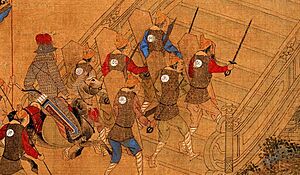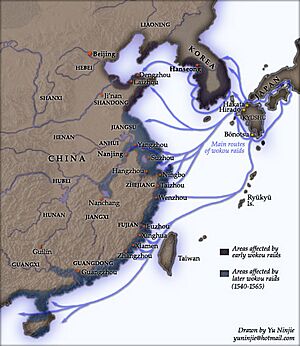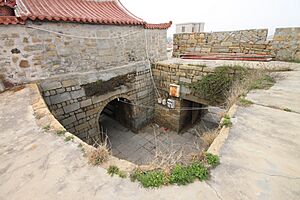Wokou facts for kids
Quick facts for kids Wokou |
|||||||||||||||||||||||||||
|---|---|---|---|---|---|---|---|---|---|---|---|---|---|---|---|---|---|---|---|---|---|---|---|---|---|---|---|

An 18th-century Chinese painting depicting a naval battle between wokou pirates and the Chinese
|
|||||||||||||||||||||||||||
| Chinese name | |||||||||||||||||||||||||||
| Chinese | 倭寇 | ||||||||||||||||||||||||||
|
|||||||||||||||||||||||||||
| Korean name | |||||||||||||||||||||||||||
| Hangul | 왜구 | ||||||||||||||||||||||||||
| Hanja | 倭寇 | ||||||||||||||||||||||||||
|
|||||||||||||||||||||||||||
| Japanese name | |||||||||||||||||||||||||||
| Kanji | 倭寇 | ||||||||||||||||||||||||||
| Kana | わこう | ||||||||||||||||||||||||||
|
|||||||||||||||||||||||||||
Wokou (Chinese: 倭寇; pinyin: Wōkòu; Japanese: 倭寇; Hepburn: Wakō; Hangul: 왜구; Hanja: 倭寇; RR: Waegu), which translates to "Japanese pirates", were pirates who raided the coastlines of China and Korea from the 13th century to the 17th century. The wokou were made of various ethnicities of East Asian ancestry, which varied over time and raided the mainland from islands in the Sea of Japan and East China Sea. Wokou activity in Korea declined after the Treaty of Gyehae in 1443 but continued in Ming China and peaked during the Jiajing wokou raids in the mid-16th century. Chinese reprisals and strong clamp-downs on pirates by Japanese authorities saw the wokou disappear by the 17th century.
Contents
History
There are two distinct eras of wokou piracy. The early wokou mostly set up camp on the outlying islands of the Japanese archipelago in the Sea of Japan, as opposed to the 16th-century wokou who were mostly non-Japanese. The early wokou raided the Japanese as well as the Chinese and Koreans.
The first recorded use of the term wokou (倭寇) is on the Gwanggaeto Stele, erected in modern Ji'an, Jilin, China to celebrate the exploits of Gwanggaeto the Great of Goguryeo (r. 391 – 413). The stele states that "wokou" ("Japanese robbers") crossed the sea and were defeated by him in 404. The term wokou is a combination of the Chinese terms Wō (倭), referring to either dwarfs or pejoratively to the Japanese, and kòu (寇) "bandit".
Early wokou
The origin of the term wokou dates back to the 4th century, but among wokou's activities, which are divided into two academic periods, the pirates called "early wokou" were borne from the Mongol invasions of Japan. As a result of the war, the coastal defense capabilities of China and Korea were significantly reduced, and the people living in Tsushima, Iki, and Gotō Islands in Kyushu suffered extreme poverty. For these reasons, wokou gradually intensified their looting on the coasts of China and Korea. Chŏng Mong-ju was dispatched to Japan to deal with the problem. During his visit, Kyushu governor Imagawa Sadayo suppressed the wokou, returning their captured property and people to Korea. In 1405, Ashikaga Yoshimitsu sent 20 captured pirates to China, where they were boiled in a cauldron in Ningbo.
According to Korean records, wokou were particularly rampant roughly from 1350. After almost annual invasions of the southern provinces of Jeolla and Gyeongsang, they migrated northwards to the Chungcheong and Gyeonggi areas. The History of Goryeo has a record of sea battles in 1380 whereby one hundred warships were sent to Jinpo to rout Japanese pirates there, releasing 334 captives. Wokou sorties decreased thereafter. The wokou were effectively expelled through the use of gunpowder technology, which the wokou lacked, after Goryeo founded the Office of Gunpowder Weapons in 1377 (which was abolished twelve years later).
In 1419, the Korean army landed in Tsushima and started the Ōei Invasion, the largest operation against the wokou. General Yi Jongmu's fleet of 227 ships and 17,285 soldiers set off from Geoje Island toward Tsushima on 19 June 1419. According to "Veritable Records of the Joseon Dynasty" a Korean history book, on 20 June the Korean army captured 129 wokou ships, burned 1,939 houses, killed 114 people, captured 21 people, and rescued 131 Chinese who the wokou had captured. On 29 June, they burned 15 wokou ships and 68 houses, killed 9 people, and rescued 15 people, including Chinese and Koreans, who had been held captive, but more than 100 soldiers were killed by wokou. On 3 July, the Korean army withdrew to Geoje Island and finally withdrew completely after giving up the re-landing and occupation of Tsushima because of the loss of Korean army and worsening weather. In the record of 10 July, the number of soldiers killed by wokou was rectified to 180. On the other hand, according to historical documents recorded by the Sō clan, the death toll of the Korean army was 2,500.
When the Treaty of Gyehae was concluded between the Joseon and Sō Sadamori of Tsushima in 1443 and the Sō clan was given trade privileges, wokou's activities along the Korean Peninsula calmed down. Some of the coastal forts built for defense against wokou can still be found in Zhejiang and Fujian. Among them are the well-restored Pucheng Fortress (in Cangnan County, Zhejiang) and Chongwu Fortress (in Chongwu, Huai'an County, Fujian), as well as the ruins of the Liu'ao Fortress in Liu'ao, Fujian.
Later wokou

According to the History of Ming, 30% of the 16th-century wokou were Japanese, and 70% were ethnic Chinese. According to Censor Du Zhonglu, in a memorial dated 1553, the pirates were 10% barbarian people, 20% Ryukyuan people, and the rest from Fujian and Ningbo areas of China.
According to Ray Huang, a Chinese-American historian, the Japanese pirates frequently collaborated with Chinese groups. Chinese explorers even led expeditions. However, the primary fighters were Japanese pirates. Japan served as a base for the Japanese pirates, and the Japanese provided all of the military expertise and equipment to the Japanese pirates.
In attempts to centralize political control, the Ming dynasty enacted trade bans with the consensus being that "unrestricted trade would lead to chaos". With maritime trade outlawed, China's navy was reduced, and as a result, they could not combat increased smuggling, which led to wokou control over the southeastern coast. Although wokou means "Japanese pirates", major wokou groups in the 16th century were led by Chinese traders whose livelihoods were halted by the Ming trade bans. Because of the extent of corruption in the Ming court, many Chinese officials had relations with the pirates and benefited from the piracy, making it difficult for central authorities to control.
Two well-known Chinese military figures involved in combating the wokou were Qi Jiguang and Yu Dayou. Yu Dayou was a Ming dynasty general assigned to defend the coast against the wokou. In 1553, a young man named Qi Jiguang became the Assistant Regional Military Commissioner of the Ming dynasty. He was assigned to "punish the bandits and guard the people", which meant taking on the wokou attacking the Ming east coast. At that time, he was 26 years old. On the eve of the following year, he was promoted to the full commissioner in Zhejiang because of his successes.
The wokou even entered the Philippines before their extermination in the 17th century. Aparri in northern Luzon was established as a pirate city-state under the patronage of the wokou. The area around Aparri was the site of the 1582 Cagayan battles between wokou and Spanish soldiers. The wokou were not limited to Aparri. The pirate-warlord Limahong attempted and failed to invade Manila and afterwards set up a temporary pirate state in Caboloan (Pangasinan) before the Spanish expelled him.
| Reign period | Region | Total | |||||
|---|---|---|---|---|---|---|---|
| Liaodong | Shandong | Jiangnan | Zhejiang | Fujian | Guangdong | ||
| Hongwu (1358–1398) | 1 | 7 | 5 | 21 | 3 | 9 | 46 |
| Jianwen (1399–1402) | 2 | 2 | |||||
| Yongle (1403–1424) | 2 | 8 | 4 | 25 | 1 | 3 | 43 |
| Hongxi (1425) | 0 | ||||||
| Xuande (1426–1435) | 1 | 1 | 1 | 3 | |||
| Zhengtong (1436–1449) | 1 | 10 | 11 | ||||
| Jingtai (1450–1456) | 1 | 1 | |||||
| Tianshun (1457–1464) | 0 | ||||||
| Chenghua (1465–1487) | 1 | 1 | 2 | ||||
| Hongzhi (1488–1505) | 1 | 1 | |||||
| Zhengde (1506–1521) | 1 | 1 | 2 | ||||
| Jiajing (1522–1566) | 5 | 207 | 192 | 158 | 39 | 601 | |
| Longqing (1567–1572) | 19 | 19 | |||||
| Wanli (1573–1619) | 1 | 5 | 9 | 15 | |||
| Total | 746 | ||||||
See also
- Piracy in the Strait of Malacca
- God of War (film)
- Limahong
- Lin Daoqian



